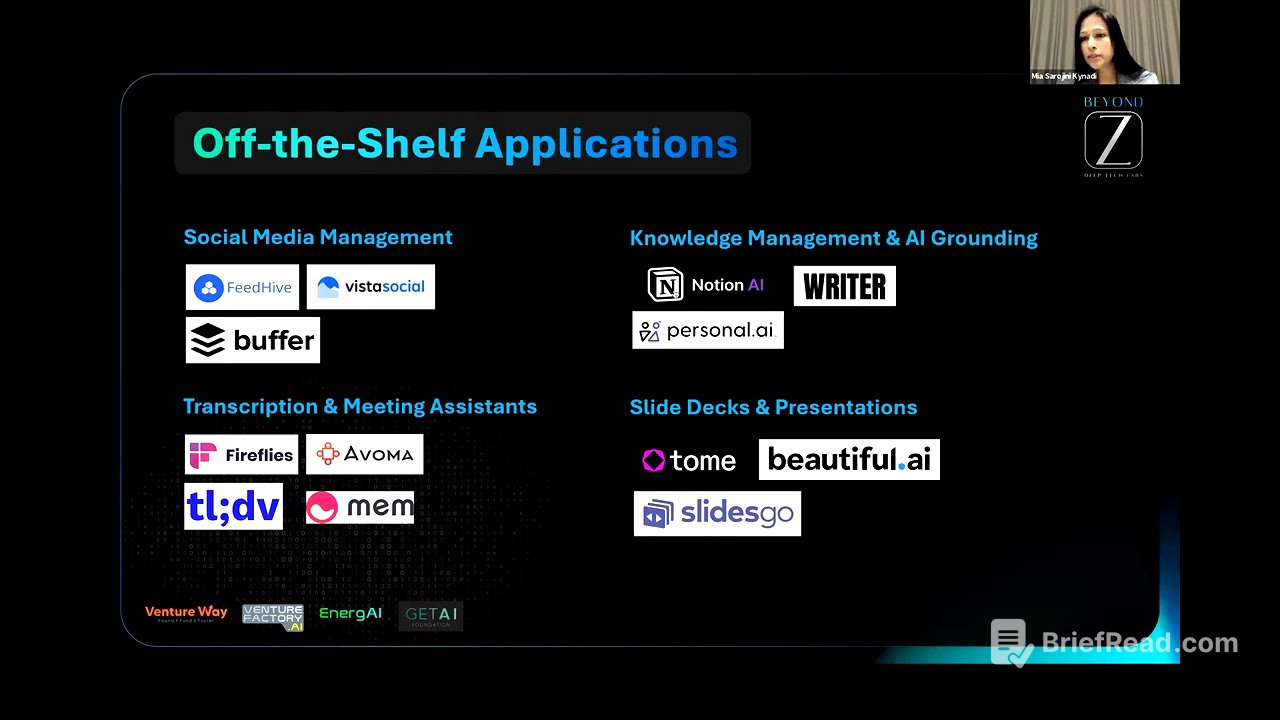TLDR;
This webinar, presented by Mia Caniti, explores how organisations and individuals can build a foundation in AI. It covers three levels of AI engagement: off-the-shelf applications, targeted AI implementations, and an AI-first approach. The discussion also includes lowering barriers to AI adoption, organisational structures for AI talent, behaviours that lead to successful AI projects, and the importance of a well-considered AI adoption roadmap.
- Three levels of AI engagement: off-the-shelf applications, targeted AI implementations, and an AI-first approach.
- Lowering barriers to AI adoption due to advancements in hardware, software, and data availability.
- Importance of a well-considered AI adoption roadmap aligned with business goals and pain points.
Introduction [0:02]
Margie Graph, President and CEO of the Greater Rockville Chamber of Commerce, introduces the first part of a three-part AI series, sponsored by Pam Clark from Clark Communications. Mia Caniti, a data scientist, entrepreneur, and early-stage investor, is introduced as the speaker. Mia will discuss how organisations and individuals can start engaging with AI, covering different levels of engagement based on appetite for the technology, budgets, and organisation size. The agenda includes lowering barriers for AI adoption, organisational structure, behaviours for successful AI projects, and the importance of an AI adoption roadmap.
Three Levels of AI Engagement [4:04]
Mia outlines three levels of AI engagement. The first is using off-the-shelf applications, which is the easiest way to start with minimal investment and training. The second level involves targeted AI implementations, where custom AI solutions are built to address specific business goals or issues. The third and most comprehensive level is an AI-first approach, where AI and data analytics are central to the business strategy.
Off-the-Shelf Applications [5:03]
Mia discusses various readily available off-the-shelf AI applications. These include chatbots like Chat GPT, Claude, Meta, and Gemini, which can reason over content, summarise information, perform basic analysis, and generate images. For web search, Perplexity.ai is recommended for its grounded responses compared to the potential "hallucinations" of other chatbots. Tools like Jasper are useful for marketing content generation, while Runway and Sora are popular for video creation and editing. Dali, Midjourney, and Stability.AI are mentioned for image generation. Other applications include voice and music generation, social media management, and knowledge management. Coca-Cola's use of a Chat GPT-based assistant led to a 90% reduction in content creation costs, and an MIT study found that using a chatbot as an assistant decreased task completion time by 40% and increased output quality by 18%.
Targeted AI Implementations [9:41]
The discussion moves to targeted AI implementations, where custom solutions are built based on an organisation's data to achieve specific goals. These solutions can include natural language processing (NLP), predictive analytics, AI agents, and computer vision. Knowledge-based management is highlighted, where chatbots are used to access internal documentation, improving productivity and information access for employees. Examples include the International Labor Organization's Answermate and JP Morgan and Chase's employee assistant. Predictive analytics is discussed for predicting future outcomes based on historical data, transforming decision-making. Use cases include predictive maintenance, healthcare (predicting patient outcomes), supply chain (preventing disruptions), banking (fraud detection), and marketing (customer segmentation).
AI Agents and Key Considerations [14:43]
AI agents, AI models with access to external tools like email clients and Google Maps, are gaining popularity. These agents can be trained to use these tools, supercharging AI models. Clara, a financial services company, uses an AI agent as a customer service representative, available 24/7 in multiple languages. Key considerations for developing targeted AI solutions include identifying opportunities and pain points in the industry, growth trajectory, and the current state of data. A well-considered AI implementation roadmap is essential.
AI-First Approach [16:39]
The AI-first approach, where AI is central to the business strategy, is explored. Forbes notes that AI-first companies are outpacing rivals. Achieving this requires a centralised data strategy and restructuring operations to leverage AI fully. The more data available, the better the algorithms and solutions, leading to a positive cycle of improvement. Established companies can transition from legacy systems to an AI-driven architecture by moving from siloed data to a centralised data architecture in phases, starting with a pilot program involving two departments.
Ant Financial Example [19:31]
Ant Financial, a spin-off from Alibaba, is presented as an example of an AI-first company. It has experienced exponential growth in the number of bank accounts, serving over a billion customers with less than 20,000 employees. In comparison, Bank of America serves 69 million customers with over 200,000 employees. Ant Financial's success is attributed to its data-driven, AI-first approach, enabling it to understand and quickly meet consumer needs.
Lowering Barriers for AI Adoption [21:01]
The barriers to AI adoption are decreasing due to easier access to hardware, software, data, and algorithms. Cloud computing platforms like Microsoft Azure, Amazon AWS, and Google Cloud provide scalable compute resources. Open-source code and frameworks are readily available, reducing the need to start from scratch. Many open-source and purchasable datasets exist, along with pre-trained models that can be fine-tuned. Because AI adoption is becoming easier, organisations that embrace it will gain a competitive advantage by making better sense of their data and decisions.
AI and Organisational Structure [23:52]
Building AI talent within an organisation can be approached in several ways: a centre of excellence model, a functional model, or a dispersed model. The centre of excellence model centralises AI skills, enabling shared learnings and best practices. The functional model embeds AI skills within functional departments, ensuring close alignment with on-the-ground needs. The dispersed model allows AI talent to work on projects as needed. The best model depends on the organisation's current structure, and ongoing evaluation is necessary to ensure the AI skills are best suited to the company's needs.
Organisational Behaviours for Successful AI Implementation [27:37]
Successful AI implementation requires a cultural change, with the workforce prepared to use insights from AI and trust the system. Focus should be on insights and processes, deploying AI in a way that is easily accessible and impactful. Strategic intent from the top down is crucial, with clear communication of benefits. Building trust in the system involves comparing AI recommendations with traditional methods and demonstrating success through metrics. A clear understanding of AI capabilities and limitations is also necessary. The AI strategy should be integrated into the broader organisational strategy, supporting existing objectives and digital initiatives.
AI Adoption Roadmap [31:37]
A well-considered AI adoption roadmap is essential for building AI solutions in an iterative way. The approach should be "why" first, then "how," focusing on business goals and pain points. Organisational readiness includes data readiness, HR readiness, business process readiness, and budget considerations. Data readiness involves how data is collected, processed, stored, secured, and catalogued. HR readiness includes preparing employees for AI, providing training, and planning the organisational structure for AI talent. Business processes need to be reimagined to leverage AI effectively, focusing on AI consumption and efficient data collection. Budget considerations include data collection and storage, infrastructure, AI models, research and development, monitoring and maintenance, and human resources.
Roadmap and Conclusion [40:15]
The roadmap should include a mix of short-term and long-term projects, with quick wins to build trust in AI. A clear path to data readiness, HR readiness, business process readiness, and budget considerations is necessary. Mia concludes the first workshop.
Q&A - Education Paths in AI [41:48]
In the Q&A session, Rebecca asks about education paths for pursuing a career in AI. Mia explains that many good quality courses are available online. The appropriate path depends on the desired role in AI. Building and training models requires a foundation in math, data, statistics, and data science. Using AI to impact work directly involves looking at specific tools and training programs for the relevant functional area, such as marketing.
Q&A - AI Policy Development [46:31]
Pam asks about developing and implementing an AI policy in a company. Mia emphasises the importance of having an AI policy, especially for content generation or dealing with sensitive data. The policy should address referencing AI-generated content, specifying how AI can and cannot be used within the organisation, and understanding copyright issues. Transparency with external stakeholders is also important. While there are no off-the-shelf policies, organisations should consider usage, data, and transparency.
Closing Remarks [51:06]
Margie announces the next workshop, "Business Strategies for AI Adoption," and thanks Mia and her team. She notes that Beyond Z has joined the chamber as a member.









